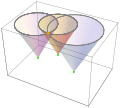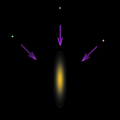Satellite navigation solution
Satellite navigation solution for the receiver's position (geopositioning) involves an algorithm. In essence, a GNSS receiver measures the transmitting time of GNSS signals emitted from four or more GNSS satellites (giving the pseudorange) and these measurements are used to obtain its position (i.e., spatial coordinates) and reception time.
The following are expressed in inertial-frame coordinates.
The solution illustrated
-
 Essentially, the solution shown in orange,
Essentially, the solution shown in orange,, is the intersection of light cones.
-
 The posterior distribution of the solution is derived from the product of the distribution of propagating spherical surfaces. (See animation.)
The posterior distribution of the solution is derived from the product of the distribution of propagating spherical surfaces. (See animation.)
Calculation steps
- A global-navigation-satellite-system (GNSS) receiver measures the apparent transmitting time,
, or "phase", of GNSS signals emitted from four or more GNSS satellites (
), simultaneously.
- GNSS satellites broadcast the messages of satellites' ephemeris,
, and intrinsic clock bias (i.e., clock advance),
as the functions of (atomic) standard time, e.g., GPST.
- The transmitting time of GNSS satellite signals,
, is thus derived from the non-closed-form equations
and
, where
is the relativistic clock bias, periodically risen from the satellite's orbital eccentricity and Earth's gravity field. The satellite's position and velocity are determined by
as follows:
and
.
- In the field of GNSS, "geometric range",
, is defined as straight range, or 3-dimensional distance, from
to
in inertial frame (e.g., ECI one), not in rotating frame.
- The receiver's position,
, and reception time,
, satisfy the light-cone equation of
in inertial frame, where
is the speed of light. The signal time of flight from satellite to receiver is
.
- The above is extended to the satellite-navigation positioning equation,
, where
is atmospheric delay (= ionospheric delay + tropospheric delay) along signal path and
is the measurement error.
- The Gauss–Newton method can be used to solve the nonlinear least-squares problem for the solution:
, where
. Note that
should be regarded as a function of
and
.
- The posterior distribution of
and
is proportional to
, whose mode is
. Their inference is formalized as maximum a posteriori estimation.
- The posterior distribution of
is proportional to
.
The GPS case
- For Global Positioning System (GPS), the non-closed-form equations in step 3 result in
in which 




- The above can be solved by using the bivariate Newton–Raphson method on
and
. Two times of iteration will be necessary and sufficient in most cases. Its iterative update will be described by using the approximated inverse of Jacobian matrix as follows:

- Tropospheric delay should not be ignored, while the Global Positioning System (GPS) specification doesn't provide its detailed description.
The GLONASS case
- The GLONASS ephemerides don't provide clock biases
, but
.


